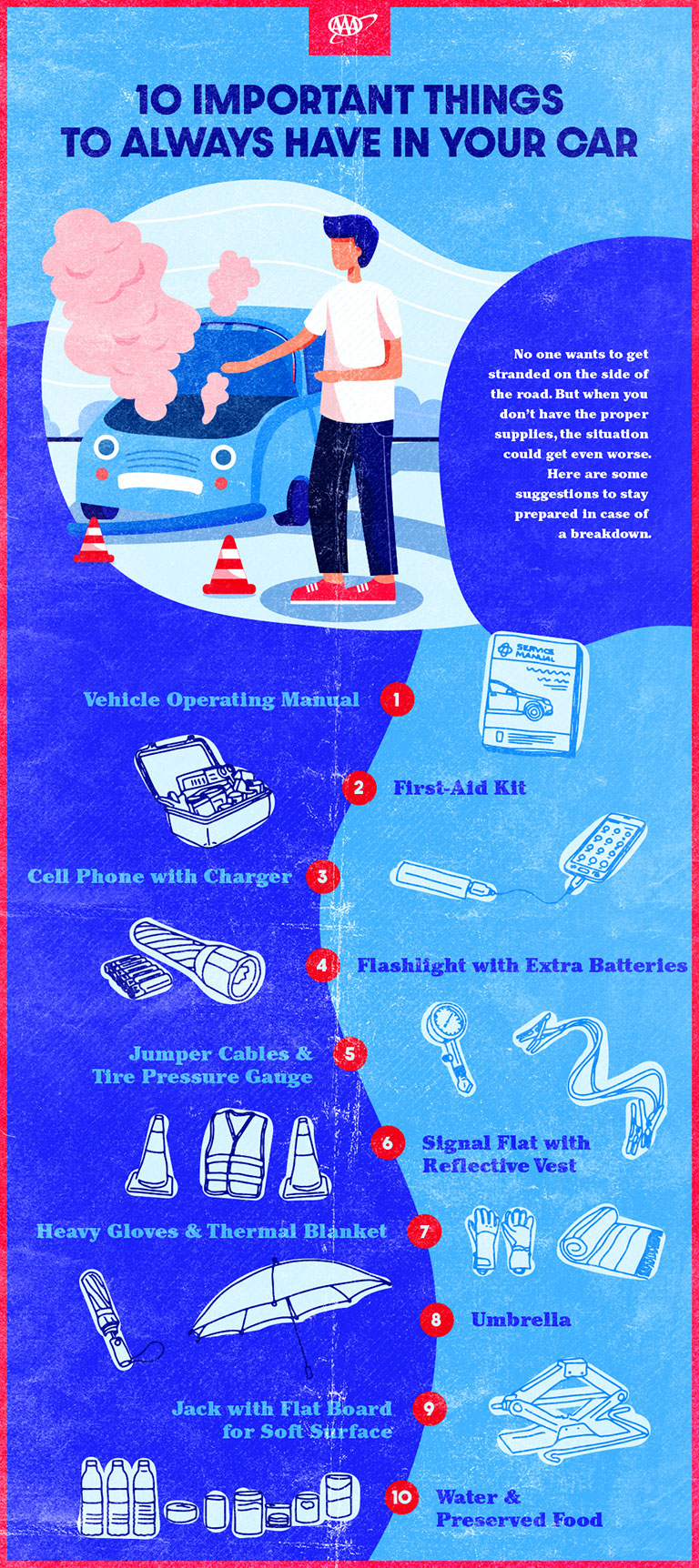

No one ever wants to get stranded on the side of the road. However, being prepared and having the proper supplies in your vehicle can keep a bad situation from getting even worse. Here are 10 crucial items for every car safety kit.

1. First aid kit
Your first aid kit doesn’t have to be large or take up a ton of space, but it should have the essentials you’d need to address an injury or emergency. Some items to include are: band-aids, gauze pads, adhesive tape, antibiotic ointment, antiseptic wipes, pain-relieving medication (such as aspirin or ibuprofen), cotton balls, curved scissors, hand sanitizer, and antihistamine (for allergic reactions).
2. Vehicle operating manual
Know where this is in your vehicle, or how to find it online, because it includes important information, instructions, and warnings for and about your vehicle. If you’ve broken down, this may help you figure out why and how to fix it.
3. Jumper cables and tire pressure guage
If your car won’t start, it could simply be a dead battery. Jumper cables can help charge your battery long enough to drive it to a shop to have it checked out. If your tire is looking low, a tire pressure gauge can help you determine if it’s safe to drive on.
4. Cell phone with charger
A charged cell phone can be critical for contacting emergency services or a tow truck. Having a charged portable charger can be helpful to ensure your phone stays charged if your vehicle dies.
5. Flashlight and extra batteries
Don’t rely on your cell phone flashlight in an emergency. If you’re stranded at night, it’s helpful to have a more powerful flashlight and extra batteries to find the problem or signal to emergency services.

6. Heavy gloves and thermal or safety blanket
If your car breaks down in winter weather or a storm, it can get cold quickly, especially at night. If temperatures drop and your vehicle won’t run, having a thermal or safety blanket can be crucial for your safety. Heavy gloves can prevent frostbite if you’re outside or changing a tire in the cold.
7. Drinking water and preserved food
If weather or terrain will make it difficult for emergency services or a tow truck to get to you, water and food will help keep up your energy and provide nutrients you may need while waiting.
8. Signal flag, retro-reflective vest, or scarf
If you’re outside the vehicle or flagging down help, having reflective gear or a signal flag can keep you safe and show drivers where you are. This is especially important if you’re stranded at night.
9. Jack with a flat board for soft surfaces
If you have a flat tire, you’ll want to have a tire jack so you can change it. A flat board, like a piece of wood or plastic, can help stabilize the jack if you find yourself parked on a soft surface, like sand.
10. Umbrella
If you’re stranded in rain or snow, stay as dry as possible with an umbrella. Staying dry can also help keep you warm.
If your vehicle does break down, first note your location. Pull off to the side of the road where it is safe, as far away from traffic as possible. Turn on your emergency flashers, raise your vehicle’s hood, and place flares or warning triangles to alert other drivers. As soon as you’re in a safe place, communicate your situation to emergency or roadside assistance services, and be sure to remain with your vehicle while you wait for help.
